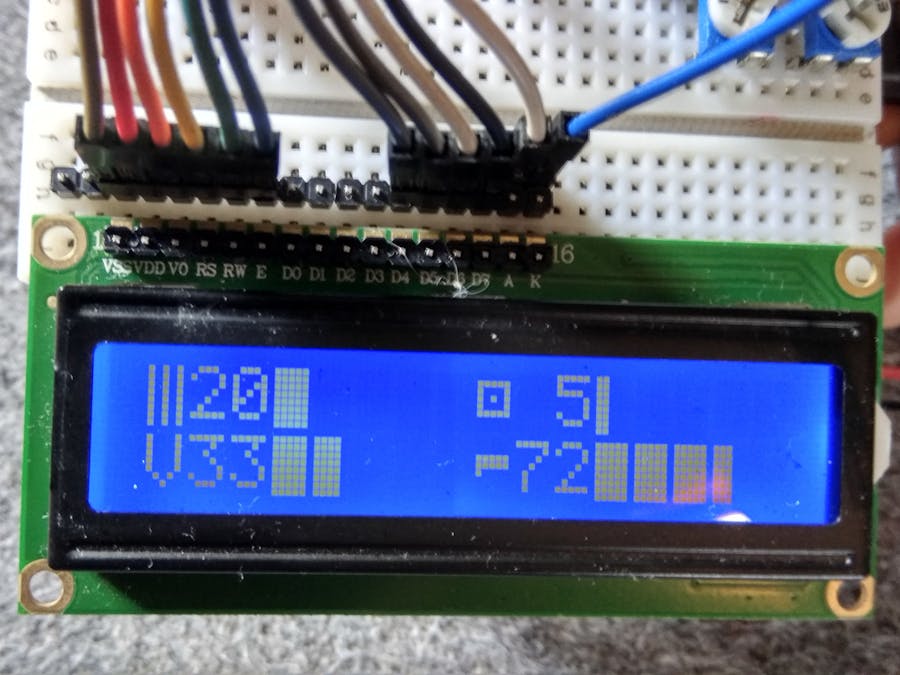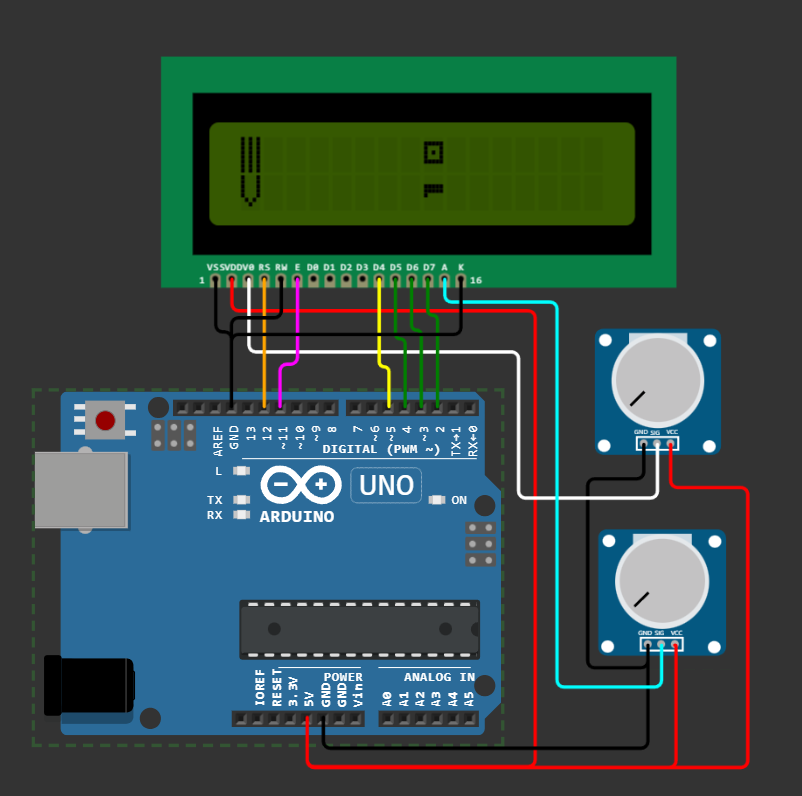/*
LiquidCrystal Library - Serial Input
Demonstrates the use a 16x2 LCD display. The LiquidCrystal
library works with all LCD displays that are compatible with the
Hitachi HD44780 driver. There are many of them out there, and you
can usually tell them by the 16-pin interface.
This sketch displays text sent over the serial port
(e.g. from the Serial Monitor) on an attached LCD.
The circuit:
* LCD RS pin to digital pin 12
* LCD Enable pin to digital pin 11
* LCD D4 pin to digital pin 5
* LCD D5 pin to digital pin 4
* LCD D6 pin to digital pin 3
* LCD D7 pin to digital pin 2
* LCD R/W pin to ground
* 10K resistor:
* ends to +5V and ground
* wiper to LCD VO pin (pin 3)
Library originally added 18 Apr 2008
by David A. Mellis
library modified 5 Jul 2009
by Limor Fried (http://www.ladyada.net)
example added 9 Jul 2009
by Tom Igoe
modified 22 Nov 2010
by Tom Igoe
modified 7 Nov 2016
by Arturo Guadalupi
This example code is in the public domain.
http://www.arduino.cc/en/Tutorial/LiquidCrystalSerialDisplay
*/
// include the library code:
#include <LiquidCrystal.h>
// initialize the library by associating any needed LCD interface pin
// with the arduino pin number it is connected to
const int rs = 12, en = 11, d4 = 5, d5 = 4, d6 = 3, d7 = 2;
char sheh;
LiquidCrystal lcd(rs, en, d4, d5, d6, d7);
char heh=0;
char input[99]={};
int count=0;
int realsize=0;
//char dummy[99]={};
String dummy;
int cnt=0;
int cnt2=0;
int parsed[4]={};
float parsedbar[4]={};
byte blocks0[8] = {
0b10000,
0b10000,
0b10000,
0b10000,
0b10000,
0b10000,
0b10000,
0b10000
};
byte blocks1[8] = {
0b11000,
0b11000,
0b11000,
0b11000,
0b11000,
0b11000,
0b11000,
0b11000
};
byte blocks2[8] = {
0b11100,
0b11100,
0b11100,
0b11100,
0b11100,
0b11100,
0b11100,
0b11100
};
byte blocks3[8] = {
0b11110,
0b11110,
0b11110,
0b11110,
0b11110,
0b11110,
0b11110,
0b11110
};
byte blocks4[8] = {
0b11111,
0b11111,
0b11111,
0b11111,
0b11111,
0b11111,
0b11111,
0b11111
};
byte cpu[8] = {
0b00000,
0b11111,
0b10001,
0b10101,
0b10001,
0b11111,
0b00000,
0b00000
};
byte ram[8] = {
0b10101,
0b10101,
0b10101,
0b10101,
0b10101,
0b10101,
0b10101,
0b10101
};
byte gpu[8] = {
0b00000,
0b00000,
0b11111,
0b11111,
0b10000,
0b00000,
0b00000,
0b00000
};
byte internet[8] = {
0b00000,
0b00100,
0b01010,
0b10001,
0b00100,
0b01010,
0b10001,
0b00000
};
void setup() {
// set up the LCD's number of columns and rows:
lcd.begin(16, 2);
lcd.createChar(0,blocks0);
lcd.createChar(1,blocks1);
lcd.createChar(2,blocks2);
lcd.createChar(3,blocks3);
lcd.createChar(4,blocks4);
lcd.createChar(5,cpu);
lcd.createChar(6,ram);
lcd.createChar(7,gpu);
// initialize the serial communications:
lcd.setCursor(0,0);
lcd.write(byte(6));
lcd.setCursor(8,0);
lcd.write(byte(5));
lcd.setCursor(0,1);
lcd.print("V");
lcd.setCursor(8,1);
lcd.write(byte(7));
// lcd.createChar(4,blocks4);
Serial.begin(9600);
}
void loop() {
// when characters arrive over the serial port...
cnt=0;
cnt2=0;
memset(input, 0, sizeof(input));
memset(parsed, 0, sizeof(parsed));
dummy="";
// memset(dummy, 0, sizeof(dummy));
count=0;
realsize=0;
if (Serial.available()) {
// wait a bit for the entire message to arrive
delay(100);
// clear the screen
// lcd.clear();
// read all the available characters
while (Serial.available() > 0) {
// display each character to the LCD
heh=Serial.read();
if(heh!='\n'){
input[count]=heh;
// Serial.print("count = ");
// Serial.print(count);
// Serial.print(heh);
count++;
// lcd.write(heh);
Serial.print(heh);
}
}
for(int i=0;i<sizeof(input);i++){
if(input[i]){
realsize++;
// Serial.print(input[i]);
}
else{
break;
}
}
for(int i=0;i<=realsize;i++){
if(input[i]=='-'||i==realsize){
Serial.println("space");
cnt=0;
parsed[cnt2]=dummy.toInt();
Serial.println(parsed[cnt2]);
dummy="";
// memset(dummy, 0, sizeof(dummy));
cnt2++;
}
else{
Serial.println("data");
dummy+=input[i];
Serial.println(dummy);
}
}
Serial.print("realsize= ");
Serial.println(realsize);
Serial.println(sizeof(input));
Serial.println("parsed results:");
for(int i=0;i<4;i++){
Serial.println(parsed[i]);
}
cnt=0;
// loop over the columns:\
cnt=0;
for (int thisRow = 0; thisRow < 2; thisRow++) {
// loop over the rows:
for (int thisCol = 1; thisCol < 16; thisCol+=8) {
// set the cursor position:
lcd.setCursor(thisCol, thisRow);
// print the letter:
if(parsed[cnt]>99){
lcd.print("XX");
}
else{
if(parsed[cnt]<10){
lcd.print(" ");
}
lcd.print(parsed[cnt]);
}
cnt++;
}
}
cnt=0;
for(int i=0;i<2;i++){
for(int j=3;j<16;j+=8){
parsedbar[cnt]=parsed[cnt]*25;
parsedbar[cnt]/=100;
Serial.print("before round");
Serial.println(parsedbar[cnt]);
parsedbar[cnt]=ceil(parsedbar[cnt]);
Serial.print("after round");
Serial.println(parsedbar[cnt]);
lcd.setCursor(j, i);
cnt2=0;
while(true){
if(parsedbar[cnt]>5){
lcd.write(byte(4));
parsedbar[cnt]-=5;
cnt2++;
}
else if(parsedbar[cnt]>0){
lcd.write(byte(parsedbar[cnt]-1));
cnt2++;
break;
}
else{
break;
}
}
Serial.print(cnt2);
Serial.print("asdf");
cnt2=5-cnt2;
Serial.print(cnt2);
for(int k=0;k<cnt2;k++){
lcd.print(" ");
}
// lcd.print(parsedbar[cnt]);
cnt++;
}
}
memset(parsed, 0, sizeof(parsed));
}
}




_ztBMuBhMHo.jpg?auto=compress%2Cformat&w=48&h=48&fit=fill&bg=ffffff)







Comments